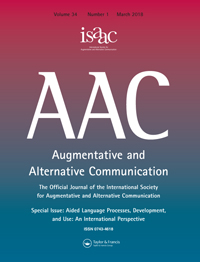From the abstract: "Although high-tech augmentative and alternative communication (AAC) is commonly used to teach social-communication skills to people with autism spectrum disorder or intellectual disabilities who have complex communication needs, there is a critical need to evaluate the efficacy of this approach. The aim of this systematic review was to evaluate the quality of single-case experimental design research on the use of high-tech AAC to teach social-communication skills to individuals with autism spectrum disorder or intellectual disabilities who have complex communication needs, to determine if this intervention approach meets the criteria for evidence-based practices as outlined by the What Works Clearinghouse. Additionally, information on the following extended methodological standards is reported on all included studies: participant description, description of setting and materials, interventionist description, baseline and intervention description, maintenance, generalization, procedural integrity, and social validity. The results from 18 multiple-baseline or multipleprobe experiments across 17 studies indicate that using high-tech AAC to teach social-communication skills to individuals with autism spectrum disorder or intellectual disabilities and complex communication needs can be considered an evidence-based practice, although the review of comparison (i.e., alternating treatment) design studies did not indicate that high-tech AAC is significantly better than low-tech AAC."
2018
Morin, K. L., Ganz, J. B., Gregori, E. V., Foster, M. J., Gerow, S. L., Genç-Tosun, D., & Hong, E. R. (2018). A systematic quality review of high-tech AAC interventions as an evidence-based practice. Augmentative and Alternative Communication, 34, 104-117.
10.1080/07434618.2018.1458900

